Best Practices Articles

Maximizing Business Growth: The Ultimate Guide to Channel Partner Management
In the dynamic landscape of business growth and customer outreach, channel partners have emerged as pivotal players. These alliances can significantly extend a company’s market reach, enhance product distribution, and fortify its competitive edge. But what exactly constitutes a channel partner, and how can businesses manage a partner network to realize its full potential?
Channel partners collaborate with manufacturers or producers to market and sell products or services. They act as an extension of the brand, often providing a crucial link between the product and the end-user. There are many types of channel partners, ranging from distributors, resellers, and agents to value-added resellers (VARs), each playing a unique role in the distribution chain.
Identifying and recruiting the right channel partners is a nuanced process that requires a strategic approach. It involves understanding your business goals, recognizing the strengths of potential partners, and aligning those with your company's vision. The benefits of cultivating a robust channel partner network include expanded sales territories, diversified revenue streams, and enhanced product offerings.
Choosing the right partners is critical. It requires careful evaluation of the partner's market position, compatibility with your business culture, and ability to deliver on mutual goals. Once they are on board, integrating channel partners into your overall business strategy becomes the next vital step, ensuring every player moves towards a common objective.
However, managing channel partners has its challenges. It demands continuous communication, regular performance assessments, and the flexibility to evolve partnerships over time. Best practices in channel partnership management revolve around transparency, shared resources, and mutual support, all of which foster a mutually profitable and sustainable relationship.
As we look to the future, channel partnerships are poised to become even more strategic. Recent trends indicate a shift towards technology-driven collaboration and data sharing. Understanding and responding to these trends is crucial for businesses aiming to stay ahead.
In this article, we will explore the intricacies of channel partnerships, covering the different types of partners and partnerships, the best practices for managing these relationships, the future trends shaping them, and much more. By the end of this article, you'll have a more precise roadmap for effectively integrating channel partners into your business strategy.
What are the different types of channel partners?
Channel partners are diverse entities that collaborate with a company to market and sell its products or services. They can be categorized based on their business model, customer base, and the value they add. ZINFI's Unified Partner Management platform recognizes the following types of channel partners:
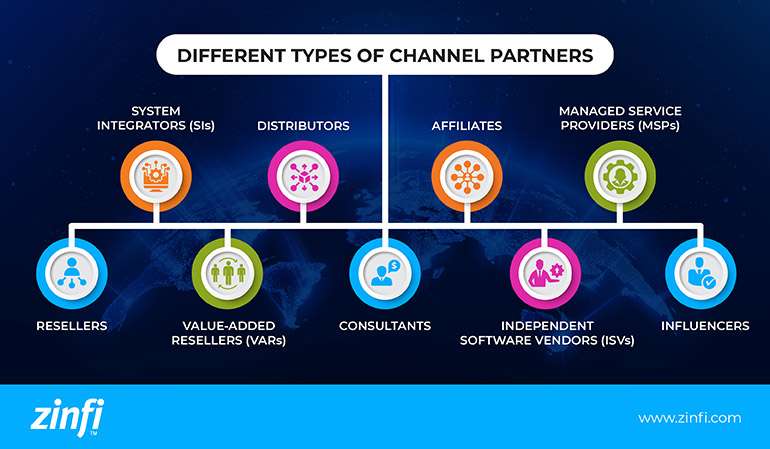
- Resellers: These partners buy products from manufacturers or service providers and sell them to customers. They may be generalists or specialists in a particular industry or product type.
- Distributors: Distributors purchase large quantities of products and distribute them to smaller resellers or retailers. They often provide additional services such as product bundling, inventory management, and logistics support.
- Value-Added Resellers (VARs): VARs enhance the value of a manufacturer's products by adding their services or products before reselling the combined solution. This could include installation services, additional hardware, or custom software applications.
- System Integrators (SIs): These partners specialize in creating complex IT solutions by integrating multiple products from different vendors. They help ensure that all components of an IT system work together seamlessly.
- Managed Service Providers (MSPs): MSPs offer managed services for various IT and business functions. They typically operate under a subscription model, providing ongoing service and support.
- Consultants: Consultants offer expert advice and may help businesses choose the right products or services. They may also assist with implementation and optimization.
- Independent Software Vendors (ISVs): ISVs develop and sell their software products, which can complement or enhance the functionality of a manufacturer's products.
- Affiliates: Affiliate partners promote a company's products or services in exchange for a commission on sales generated through their marketing efforts.
- Influencers: These partners leverage their authority or following in a specific niche to influence potential buyers and drive sales.
ZINFI's platform provides tools and applications designed to help organizations manage these diverse types of partners, offering features like partner programs management, partner contracts management, and partner business planning. By utilizing such a platform, companies can effectively engage with different types of channel partners in a personalized way, aligning their strengths and capabilities with the company's sales and marketing strategies.
How to find and recruit channel partners?
Finding and recruiting the right channel partners is critical for companies seeking to expand their market reach and sales capabilities. ZINFI's approach to partner recruitment involves several strategic steps:
- Identify Potential Partners: The first step is to identify potential partners with the capabilities and market presence that align with your business goals. This involves market research and analysis to understand which types of partners are most likely to succeed with your products or services.
- Develop a Value Proposition: To attract the best partners, you need a compelling value proposition that outlines the benefits of partnering with your company. This should include financial incentives, marketing and sales support, training resources, and a clear path to profitability for the partner.
- Use Targeted Marketing: Employ targeted marketing strategies to reach potential partners. This can include digital marketing, industry events, and direct outreach through sales teams.
- Leverage Technology: Utilize partner relationship management (PRM) platforms like ZINFI's to streamline recruitment. These platforms can help you manage partner profiles, track engagement, and communicate effectively with potential partners.
- Offer Comprehensive Training: Provide extensive training to ensure partners are well-equipped to sell and support your products. ZINFI's partner learning management system can deliver training materials and track partner progress.
- Build Strong Relationships: Foster solid and ongoing relationships with your partners. Regular communication, joint business planning, and performance tracking are critical to a successful partnership.
- Evaluate and Optimize: Continuously evaluate the performance of your channel partners and the effectiveness of your recruitment strategies. Use feedback and performance data to optimize your approach.
By following the above-mentioned steps and leveraging the tools provided by ZINFI's Unified Partner Management platform, companies can find and recruit channel partners to help them grow their business and reach new customers.

What are the benefits of having channel partners?
Channel partners can offer many benefits to a company, helping amplify its market presence and sales efforts. Here are some of the key advantages:
- Extended Reach: Channel partners can help a company expand its reach into new markets and territories without significantly increasing direct sales resources.
- Cost Efficiency: Working with channel partners can be more cost-effective than scaling an internal sales force, especially when entering new markets or targeting smaller customer segments.
- Localized Expertise: Partners with a strong local presence can offer valuable insights into local market conditions and customer preferences, which can be critical for tailoring marketing and sales strategies.
- Increased Sales Velocity: A well-managed channel partner program can lead to a more rapid sales cycle, as partners leverage their existing relationships and expertise to sell more effectively.
- Scalability: Channel partners enable scalability. As demand grows, partners can quickly ramp up their sales efforts to meet customer needs without the lead time required to expand an internal team.
- Innovation: Partners often bring new ideas and perspectives that can lead to product improvements or innovative go-to-market strategies.
- Customer Satisfaction and Support: Partners can provide customers additional support and services, improving customer satisfaction and loyalty.
- Risk Mitigation: Diversifying your sales strategy through multiple partners can mitigate the risk of relying on a single sales channel.
- Enhanced Product Offering: Value-added resellers and system integrators can enhance a company's product offering by bundling it with additional services or technologies, making it more attractive to end-users.
- Feedback Loop: Channel partners can provide valuable feedback from the market, which can inform product development and marketing strategies.

ZINFI's Unified Partner Management platform is designed to help companies realize these benefits by providing a comprehensive suite of tools for managing all aspects of the partner lifecycle, from recruitment and onboarding to sales enablement and performance tracking.
By leveraging ZINFI's solutions, companies can build and maintain a strong channel partner network that drives growth and success.
How to Choose the Right Channel Partners for Your Business
Choosing the right channel partners is a strategic decision that can significantly impact the success of your business. The right partners can extend your market reach, enhance your product offerings, and drive revenue growth. Here are the steps to ensure you select the best channel partners for your business:
- Define Your Ideal Partner Profile: Start by understanding what you need in a channel partner. Consider factors such as market presence, customer base, sales and marketing capabilities, technical expertise, and cultural fit. An ideal partner should strongly align with your business objectives and values.
- Conduct Thorough Research: Once you have a profile, research potential partners thoroughly. Look into their business history, reputation in the market, financial stability, and the success they've had with other partnerships. This information can be gathered through market analysis, customer reviews, and partner databases.
- Evaluate Their Sales and Marketing Strength: A channel partner's ability to sell and market your products is crucial. Assess their sales force, marketing strategies, and the success of their previous campaigns. They should have a proven track record of effectively reaching and serving your target customer segments.
- Assess Technical and Support Capabilities: Your partners should be able to sell and support your products. Evaluate their technical knowledge, support infrastructure, and the quality of customer service they provide. They should have the resources and expertise to troubleshoot issues and maintain customer satisfaction.
- Look for Commitment to Partnership: Good channel partners are committed to the partnership's success. They should be willing to invest in training, marketing, and sales efforts. Their willingness to collaborate and invest time and resources strongly indicates their commitment.
- Use a Partner Management System: Tools like ZINFI's Unified Partner Management platform can help you manage the entire partner lifecycle, from recruitment to performance analysis. Such systems also provide insights into potential partners and help you make data-driven decisions.
- Plan for Long-Term Relationships: Choose partners with the potential for long-term relationships. This means looking beyond immediate gains and considering how the partnership can grow and evolve. Partners that are adaptable and forward-thinking can help you navigate market changes and sustain growth.
- Legal and Financial Due Diligence: Ensure all legal and financial aspects are thoroughly vetted. This includes contracts, compliance with regulations, and a clear understanding of the financial arrangements.
Following these steps, you can select channel partners to help you achieve your business goals and create a robust and collaborative network that drives mutual success.
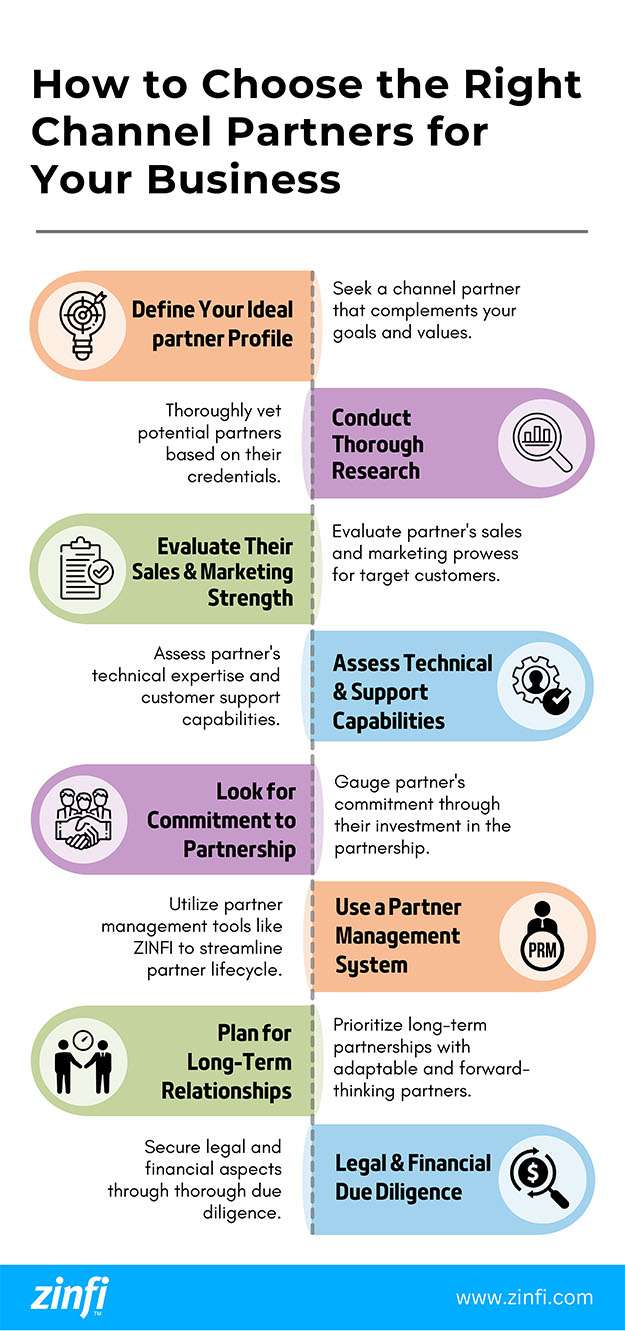
How to Get Started with Channel Partnerships
Initiating a channel partnership program is a multi-faceted process that requires careful planning and execution. Here's how to get started:
- Develop a Channel Strategy: Your channel strategy should align with your overall business goals and define how channel partners will fit into your sales and marketing efforts. It should identify the types of partners you need, the markets they will serve, and the goals you aim to achieve through the partnership.
- Create a Partner Program: Design a comprehensive program outlining the benefits of partnering with your company, as well as requirements and expectations. This program should include training, support, incentives, and performance metrics details.
- Set Up Partner Recruitment: Begin recruiting partners by promoting your partner program through various channels. This can include industry events, online marketing, and direct outreach. Make sure to communicate the value proposition of your partnership.
- Provide Training and Certification: Offer extensive training and certification programs to ensure your partners are well-equipped to sell and support your products. This should cover product knowledge, sales techniques, and customer service skills.
- Implement a Partner Portal: A partner portal is a centralized platform where partners can access resources, manage leads, register deals, and collaborate with their teams. This portal is crucial for maintaining communication and providing the tools for partners to succeed.
- Establish a Support Structure: Set up a dedicated support structure for your channel partners. This includes sales support, marketing assistance, technical support, and regular check-ins to ensure partners have everything they need to be successful.
- Monitor and Manage Performance: Use key performance indicators (KPIs) to monitor your partners' performance. Regularly review these metrics and work with partners to optimize their performance and address challenges.
- Foster Strong Relationships: Build strong, personal relationships with your channel partners. Regular communication, trust, and mutual respect are critical to a successful partnership.
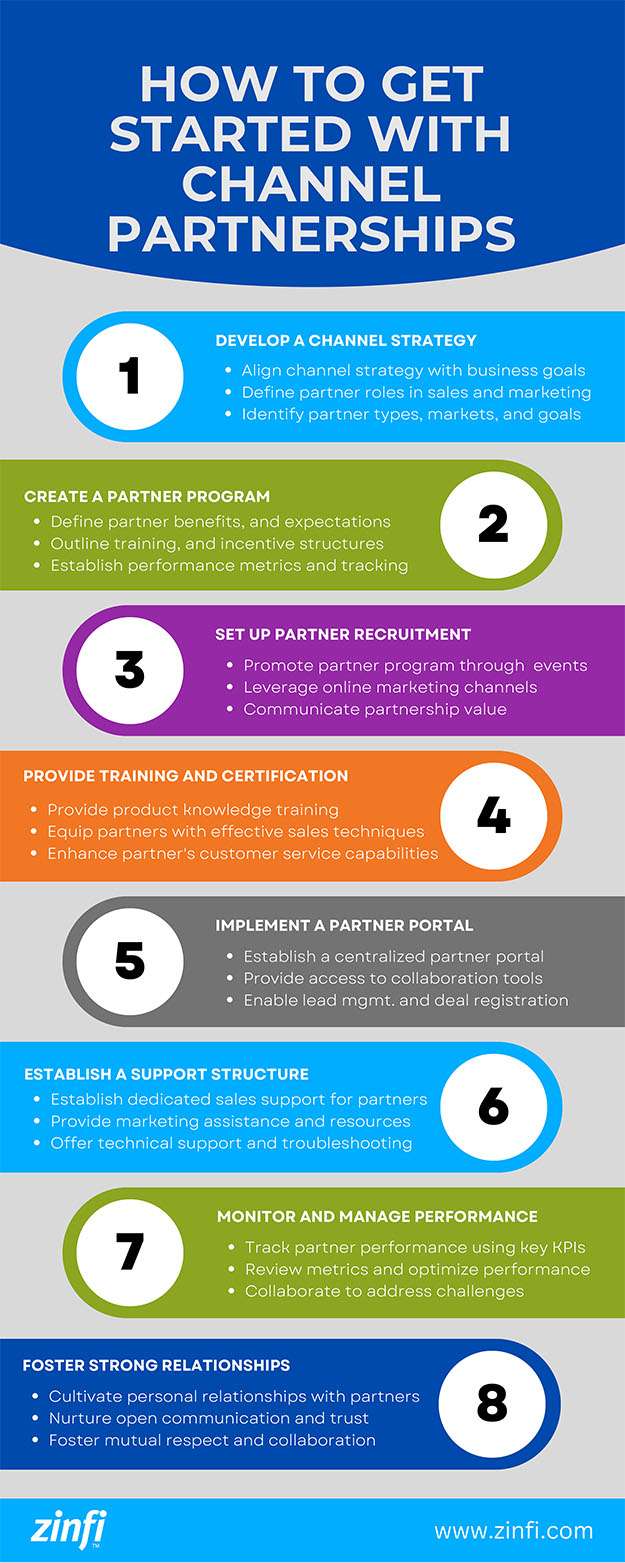
By taking these steps, you can establish a solid foundation for your channel partnerships and set the stage for a successful and profitable program.
How to Align Channel Partners with Overall Business Strategy
Aligning channel partners with your overall business strategy ensures their efforts contribute to your company's objectives. Here's how to achieve this alignment:
- Communicate Your Business Vision: Share your company's vision, goals, and strategic plans with your channel partners. They should understand where your business is headed and their role.
- Integrate Partners into Strategic Planning: Involve your channel partners in the strategic planning process. This helps ensure that their business plans and initiatives align with your company's direction.
- Establish Joint Objectives: Set clear, measurable objectives aligned with your strategic goals. These objectives should be specific, measurable, achievable, relevant, and time-bound (SMART) and communicated clearly to your partners.
- Create Incentive Programs: Develop incentive programs that reward partners for behaviors and outcomes that support your strategic objectives. Rewards might include bonuses for targeting specific customer segments, exceptional customer service rewards, or market expansion incentives.
- Provide the Necessary Tools and Resources: Equip your partners with the marketing materials, sales tools, and product information they need to represent your brand and meet strategic objectives effectively.
- Regularly Review and Adjust Strategies: Conduct regular strategy reviews with your channel partners to ensure their activities align with your business goals. Be prepared to make adjustments based on performance data and market changes as needed.
- Leverage Technology for Insights and Collaboration: Utilize partner relationship management platforms to gain insights into partner activities and foster collaboration. These platforms can help you track performance, share information, and communicate effectively with your partners.
- Cultivate a Culture of Continuous Improvement: Encourage continuous improvement among your channel partners. This involves regular training, sharing best practices, and providing feedback.
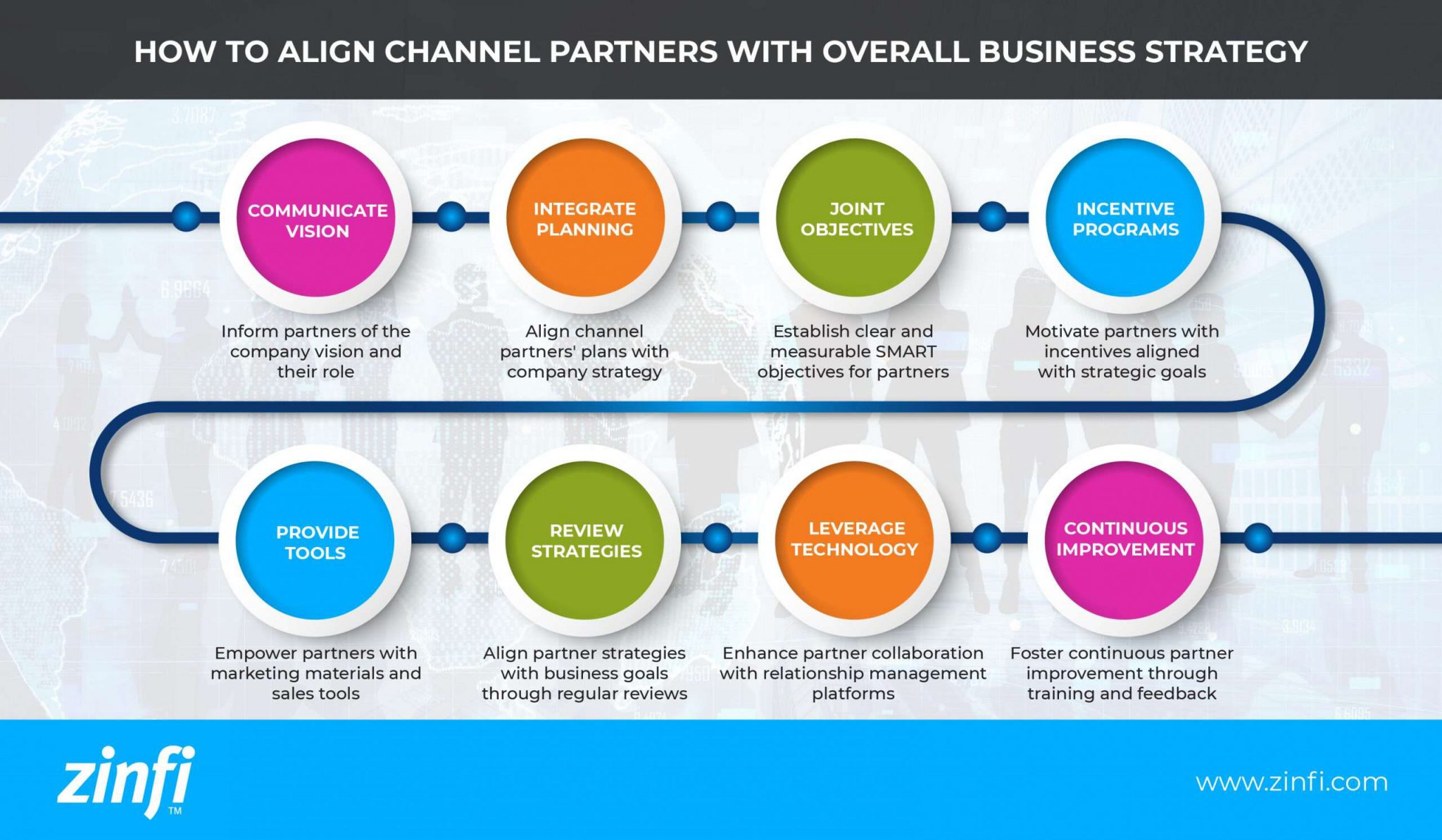
By aligning your channel partners with your overall business strategy, you can create a cohesive and focused effort that drives your business forward. This alignment is crucial for maximizing the impact of your channel partnerships and achieving long-term success.
What are the challenges of managing channel partners?
Managing channel partners presents a diverse set of challenges, including the alignment of diverse objectives, ensuring effective communication, tracking and refining performance, and maintaining brand integrity across a variety of independent entities.
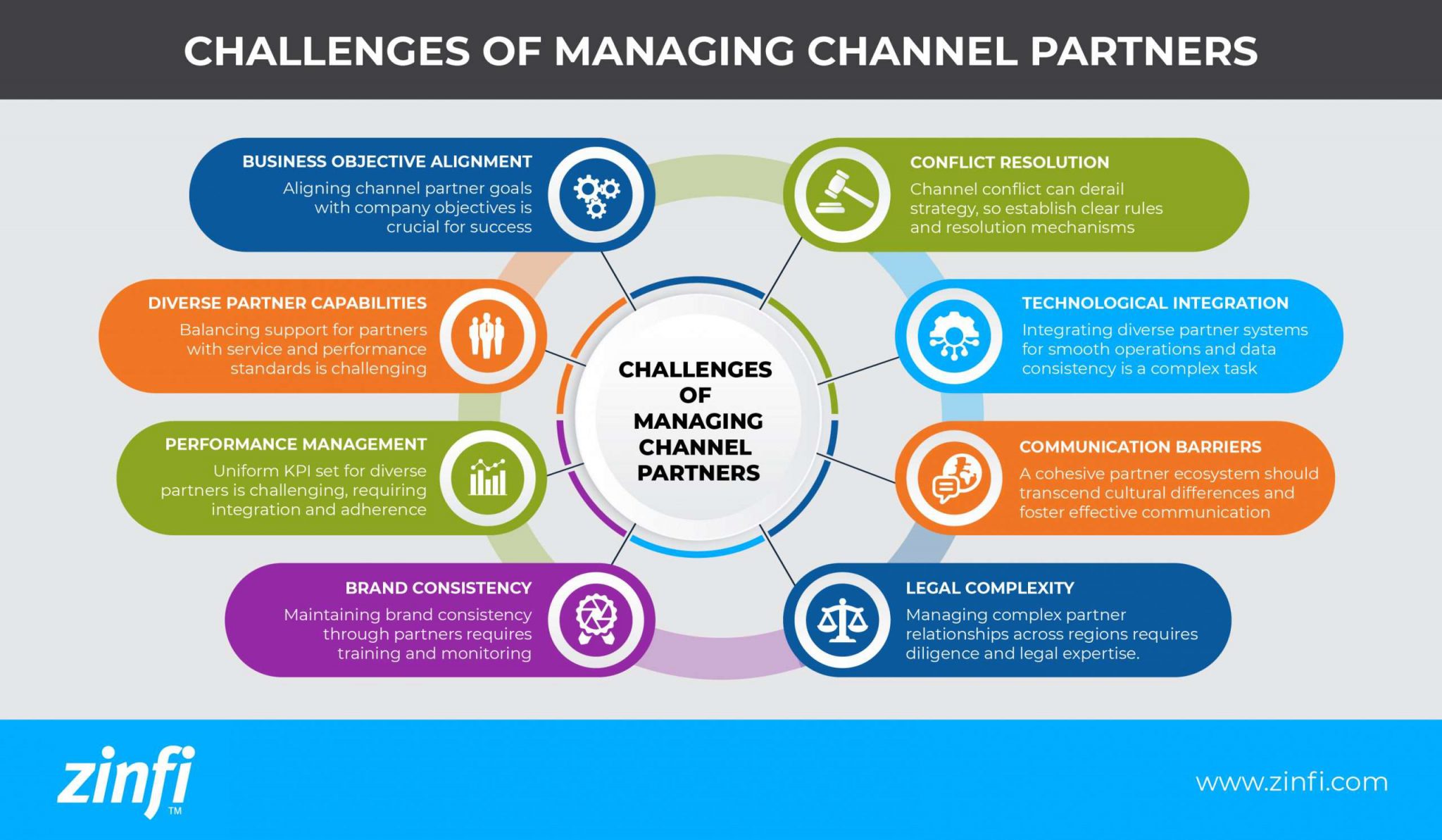
- Alignment of Business Objectives: One of the most significant challenges is ensuring that the channel partners' business goals align with the company's strategic objectives. This often requires regular alignment sessions and the creation of shared plans to ensure everyone is working towards the same outcomes.
- Diverse Partner Capabilities: Channel partners have varying degrees of expertise, market knowledge, and sales capabilities. Tailoring support to fit each partner's unique needs while striving for consistency in service and performance standards is a complex balancing act.
- Performance Measurement and Management: Establishing a uniform set of KPIs that accurately reflect the performance of diverse channel partners is challenging. It involves integrating different reporting systems and ensuring that partners adhere to the agreed-upon metrics.
- Brand Compliance and Consistency: Ensuring channel partners adhere to brand guidelines and accurately represent the company's products and services requires comprehensive training and regular monitoring.
- Conflict Resolution: Channel conflict, whether between different partners or between partner sales and the company's direct sales, can undermine the effectiveness of your channel strategy. Developing clear rules of engagement and conflict resolution mechanisms is essential.
- Technological Integration: Integrating diverse technological systems across various partners to ensure smooth operations and data consistency can be a daunting technical and logistical challenge.
- Cultural and Communication Barriers: A cohesive, well-functioning partner ecosystem must be able to overcome cultural differences, and establish effective communication channels with partners from diverse backgrounds.
- Legal and Financial Complexity: Navigating the legal and financial complexities of partner relationships, particularly across multiple regions with varying regulations, requires diligent management and often legal expertise.
How do we evolve channel partnerships over time?
Nurturing channel partnerships that can evolve over time is a strategic necessity in a dynamic business environment. It involves continuous assessment, fostering innovation, adapting to market changes, and maintaining a strong collaborative relationship with partners.
- Continuous Partnership Assessment: Regular evaluation of the partnership's performance against market changes and the company's strategic direction is crucial for timely adaptations and growth.
- Training and Development: Companies should provide ongoing training and development opportunities to ensure that channel partners' skills and knowledge remain current and competitive.
- Innovation and Collaboration: Encouraging innovation within the partnership can lead to new business models and strategies that drive mutual growth and adaptability.
- Strategic Communication: Keep communication channels open for strategic discussions to ensure both parties are aligned with the company’s vision and market dynamics.
- Program Restructuring: Periodically restructuring partner programs helps to phase out underperforming partnerships and reinforce successful ones, aligning with the company's evolving goals.
- Adaptability and Flexibility: Cultivating partner adaptability allows quick responses to new opportunities and challenges, and helps the partnership remain relevant.
- Shared Success Metrics: To foster a shared sense of direction and purpose, it's essential to develop and agree on shared metrics that reflect the company's and the partners' definitions of success.

What are the best practices for channel partnership management?
Best practices in channel partnership management focus on a strategic approach to partner selection, clear communication, comprehensive support, and a collaborative culture.
 Download the best practices guidebook
Download the best practices guidebook
- Selective Partner Recruitment: The first step toward a successful partnership is to identify and recruit channel partners whose business goals and values align with your company's.
- Structured Onboarding Process: A well-defined onboarding process helps new partners quickly understand the company's products, services, and policies, setting the stage for a productive relationship.
- Clear and Consistent Communication: Establish regular communication routines to ensure expectations are managed and partners are kept informed of any changes in strategy or policy.
- Performance-Based Incentives: Create incentive programs that reward partners for behaviors that align with strategic objectives. This encourages performance that benefits both the partner and the company.
- Robust Partner Relationship Management: Invest in a comprehensive PRM system that provides a comprehensive set of tools for effective partnership management, including performance tracking and resource distribution.
- Collaborative Culture: Cultivate a culture that treats partners as an extension of the company to foster trust and encourage a more integrated approach to achieving shared goals.
- Commitment to Continuous Improvement: Encourage and facilitate continuous improvement through regular training, sharing of best practices, and constructive feedback to help partners stay competitive and aligned with the company's evolving needs.
What are the future trends in channel partnerships?
The future of channel partnerships is shaped by rapid technological advancements, evolving business models, and a growing emphasis on sustainability and customer experience. These trends are guiding how companies and their partners collaborate and succeed together.

- Data-Driven Decision-Making: The increasing use of data analytics and AI in channel partnerships allows for more informed decision-making and better targeting of customer needs.
- Flexible and Dynamic Models: As markets evolve, so too must channel partnerships, with a trend towards more flexible and project-based collaborations that can quickly adapt to new opportunities.
- Subscription and Service-Based Shifts: The move towards subscription-based and as-a-service models is changing how partners sell and support products, shifting the focus to long-term customer relationships and recurring revenue streams.
- Sustainability and Responsibility: Partnerships are increasingly being evaluated based on their commitment to sustainability and social responsibility, reflecting broader societal values and customer expectations.
- Seamless Customer Experience: The trend towards a unified customer experience requires closer integration between companies and their channel partners, ensuring consistency and quality across all touchpoints.
- Technological Convergence: Advanced technologies facilitate better communication, collaboration, and data sharing, which are essential for the success of future channel partnerships.
- Global Expansion: Channel partnerships are becoming more global, requiring strategies to navigate international regulations, cultural differences, and diverse market conditions.
Conclusion
Channel partners are more than just a route to market; they are a strategic asset that, when managed well, can become a source of sustained competitive advantage. Throughout this article, we have explored the various facets of channel partnerships, from their diverse types to the strategies for finding, recruiting, and managing them effectively. We've also touched upon the challenges of these partnerships and the best practices to overcome them.
The key takeaway is that successful channel partnerships are built on a foundation of alignment, communication, and mutual benefit. By choosing the right partners, aligning their activities with your business strategy, and managing the relationships effectively, your company can unlock new markets, innovate faster, and deliver better customer experiences.
As we look to the future, it's clear that channel partnerships will continue to evolve. Digital transformation, the increasing importance of data analytics, and the shift towards more collaborative and integrated partnerships are all trends that businesses need to watch and adapt to. Staying ahead of these trends will require flexibility, a willingness to change, and a commitment to fostering strong, healthy partnerships.
Channel partners and partner ecosystems are an indispensable part of modern business strategy. By effectively leveraging relationships with partners, businesses can expand their reach, enhance their operational capabilities, and drive growth in an increasingly competitive marketplace. The future of channel partnerships is bright, and it offers a world of opportunity for those who are prepared.
For more information, please download best practices article.
Best Practices Guidebook
 Mastering LinkedIn: Building Personal Brands for Social Selling
Mastering LinkedIn: Building Personal Brands for Social SellingDownload for FREE
 Unified Communications: The Backbone of Modern Digital Growth
Unified Communications: The Backbone of Modern Digital GrowthDownload for FREE
 The Channel Sales Playbook: Skills, Strategy, and Growth
The Channel Sales Playbook: Skills, Strategy, and GrowthDownload for FREE
 Blueprints for Vertical Success Best Practices
Blueprints for Vertical Success Best PracticesDownload for FREE
 The Future of Partner Enablement: From Enablement Gaps to Global Advantage
The Future of Partner Enablement: From Enablement Gaps to Global AdvantageDownload for FREE
 Reimagine Sales Development. Build a Smarter Prospecting Engine
Reimagine Sales Development. Build a Smarter Prospecting EngineDownload for FREE
 The Zero Trust Imperative: Fortifying Enterprise Security Against AI-Driven Threats
The Zero Trust Imperative: Fortifying Enterprise Security Against AI-Driven ThreatsDownload for FREE
 PartnerOps Excellence: The Definitive Guide to Scalable SaaS Ecosystems
PartnerOps Excellence: The Definitive Guide to Scalable SaaS EcosystemsDownload for FREE
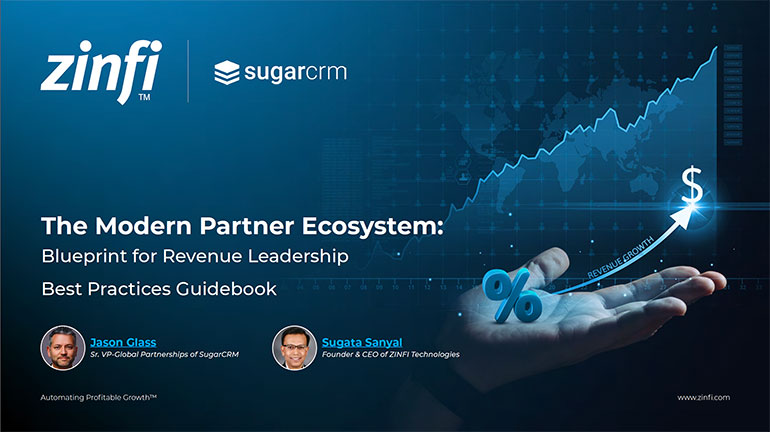 The Modern Partner Ecosystem Best Practices
The Modern Partner Ecosystem Best PracticesDownload for FREE
 Partner Marketing Reimagined: Strategies for Agile, Insight-Led Growth
Partner Marketing Reimagined: Strategies for Agile, Insight-Led GrowthDownload for FREE
 Scaling with PartnerOps Best Pratices
Scaling with PartnerOps Best PraticesDownload for FREE
 Leading with Partner Programs Best Pratices
Leading with Partner Programs Best PraticesDownload for FREE
 The Partner-First Blueprint: Scaling Trust, Intelligence, and Ecosystem Growth
The Partner-First Blueprint: Scaling Trust, Intelligence, and Ecosystem GrowthDownload for FREE
 Unlock Scalable Growth with The Partner Marketing Growth Blueprint
Unlock Scalable Growth with The Partner Marketing Growth BlueprintDownload for FREE
 From TikTok to LinkedIn: Social Selling Across the Generational Divide
From TikTok to LinkedIn: Social Selling Across the Generational DivideDownload for FREE
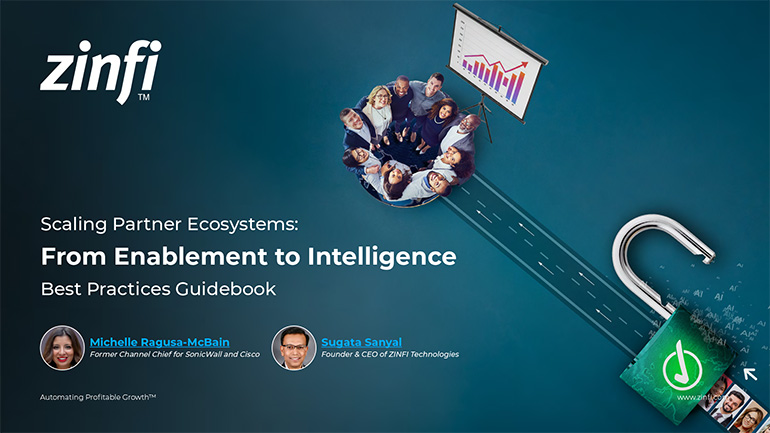 Scaling Partner Ecosystems: From Enablement to Intelligence
Scaling Partner Ecosystems: From Enablement to IntelligenceDownload for FREE
 The Ultimate Guide to Partner Marketing Success Best Practices
The Ultimate Guide to Partner Marketing Success Best PracticesDownload for FREE








